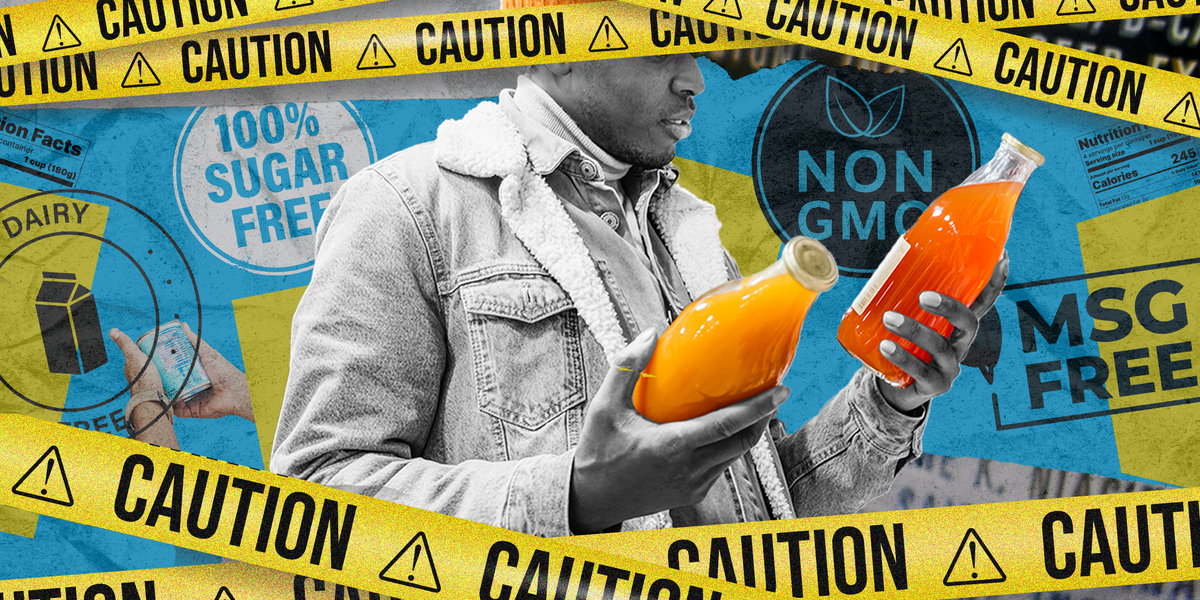I haven’t been on a dating app since 2012, but if Kristen Bell’s All In energy bar were a dating profile, it’d read like: gluten-free, soy-free, dairy-free, and GMO-free. Clean. Virtuous. Filtered for your wellness needs.
But here’s the thing: a label that tells you what a food isn’t doesn’t tell you what it is. Bell’s bars, formerly known as This Saves Lives (kinda dramatic, IMO) still pack 20 ingredients, and as a dietitian, I’d still consider the whole thing ultraprocessed.
We live in this weird era of “Not” food. No this, no that, nothing scary. But that doesn’t automatically make the food nourishing. If anything, these terms make it easier to stop asking questions about what we’re actually eating.
“Not” Doesn’t Mean Healthy
You’d think we’d be getting smarter about food labels by now. However, according to the 2025 Global State of Wellness Report by Nielsen IQ, 78 percent of people still define health by what a food doesn’t have, such as sugar, gluten, and soy, rather than what it actually contains.
That’s not just clever branding. It’s confusion by design.
Nearly 60 percent of global consumers say they feel lost when reading wellness labels. The report refers to it as “health washing,” where the front of the package claims “clean,” but the back reveals it is ultra-processed. Almost half of Millennials and Gen Z admit they trust buzzwords more than the actual ingredient list.
That’s not on them. That’s on the system.
Much of this began with good intentions. Too much sodium, sugar, and saturated fat are tied to the biggest killers in America: Those are killers like heart disease, cancer, and diabetes. According to the FDA, these are not only the leading causes of disability and death in the U.S., but also major drivers of healthcare spending.
It’s why the FDA recently rewrote the rules for what can legally be called “healthy.” Now, a product has to contribute something to your overall health: whole foods, fiber, or protein. And it must stay within strict limits on the things that put us at risk.
Marketing got us here. Nutritional science is trying to clean it up.
“Clean” Labels Still Hide “Eh” Ingredients
Over 80 percent of new packaged foods in 2025 used at least one “free-from” claim on the front of the label, according to the Nielsen IQ report. No sugar. No gluten. No dairy. No problem, right?
Not exactly.
Most of those products still qualify as ultra-processed. Reminding people that marketing terms like “free from” are still often associated with ultra-processed products wasn’t on my 2025 bingo card, but here we are.
Here are some examples:
• “No MSG” chips loaded with sodium.
• “No added sugar” granola stacked with 25g of added sugar.
• “Whole grain” cookies or “non-GMO” soda that still contain sugar.
• “No dairy” treats filled with soy, oats, nuts, seeds, coconut, and legumes. Nutrient-dense? yes. More highly processed? Also, yes.
We’ve been trained to associate absence with virtue. But taking something out doesn’t make what’s left any better.
How to Actually Read a Label
The same 2025 Global Wellness Report also notes that 71 percent of shoppers prefer fewer ingredients. But most still buy what their favorite recommends or what the package says is “clean.” So let’s flip the script.
You know that game where you ask a kid what they have, not what they don’t (Go Fish is a GOAT game btw)? The same rules apply here. If the front of the label tells you what’s missing, turn the box around and look at what’s there.
Here’s your 15-second scan:
- Protein: Great if a product has 10 to 20g per serving. More if it’s a post-workout or meal replacement.
- Fiber: 5 to 10g per serving is a solid amount. No fiber? Not a win.
- Carbs: The total grams matter less than the source; you want the majority to come from whole foods and the minority from added sugar items, such as juice.
- Fat: Some is beneficial, especially when it comes from nuts, seeds, or natural oils.
- Vitamins & minerals: Higher percentages of the daily value (DV) are better.
- Ingredients list: If it reads like a science fair project, you already know. And look out for gums, thickeners, unrecognizable sweeteners (“fruit concentrate,” “tapioca syrup”), or trendy extras that don’t actually deliver (like adaptogens in candy bars).
The Takeaway: Read the Back, Not Just the Buzzwords
If you want to support a brand or influencer, feel free to do so. Just don’t confuse clean claims with quality fuel. A flashy front label might talk a big game, but the truth is always on the back.
Some of the best foods don’t have labels at all. Think fruit. Eggs. Oats. Don’t focus on what flatters your sense of virtue. Focus on what feeds you.
Related Stories
Dezi Abeyta, RDN, is a Men’s Health Nutrition Adviser, author of Lose Your Gut Guide, and founder of Foodtalk Nutrition LLC.
